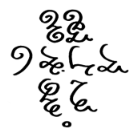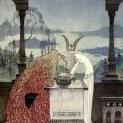Leaderboard
Popular Content
Showing content with the highest reputation on 08/09/2023 in all areas
-
Hello. Here is a piece for large orchestra which i composed sometime ago inspired by morden composers such as penderecki and ligeti. It would mean a lot of I could get some feedback on it. Thank you.1 point
-
Hi everyone, this is a short waltz I composed. It doesn't have an official title yet. Any suggestions/comments greatly appreciated. Thank you!1 point
-
I am writing a piece for orchestra which is currently unfinished. I am planning to make it a one-movement piece, and this is what I have so far. Let me know what you think and if there is anything I can improve1 point
-
This is what I have been working on for the last few weeks. Applying everything I'm learning about orchestration. Movement II is underway... See modified and expanded version below. (The picture is of my dog, who is a Spanish water dog, and his name is JOY).1 point
-
After an relatively long insterstice without composing (on account of how busy my summer has been thus far), I have finally returned with yet another Prelude and Fugue. This time, I composed a rondo-like scherzo in lieu of the prelude, whereas the fugue stands as a slightly revamped version of a composition dating back from late May 2020, the year the coronavirus pandemic struck. The title, translating from French as "the enlightened tyrant", was chosen on account of both the staunch, marccato character of the prelude, as well as the relatively whimsical modulations within the fugue. Enjoy! YouTube video link: https://www.youtube.com/watch?v=ZKIqM-gFo_o1 point
-
Hi @Bjarke, First I just come from your horror piece and it's fascinating you are in a completely different style and mood here! It's impressionistic and pentatonic here. This is a good moody piece, though I think using electronic instruments for the flute and oboe parts will be even more idiomatic for me. I agree with Luis on the usage of piano and harp here. I think in addition there can be more contrast of texture here, even if you want to depict the flying of the butterfly throughout the piece. Maybe have that flying figure rest a bit during the middle section to depict its rest and collecting honey? Otherwise it's a very lovely piece. Thx for sharing! Henry1 point
-
Hi @Bjarke, Yuck this is a horrible picture!!!!!! Don't kill me!!!!!!!!!!!! The beginning is successful to portray the scary mood with the use of low strings, that 0134 motive in different rhythm. Maybe adding a double bassoon there will be great since it's the most evil instrument I've known haha. That piano is very scary like in the Halloween. With those whirling strings and those forcing brass it's scary. That clarinet entry is very creepy. The strings after it is scary in the other aspect as it becomes more a psychological thriller like in the Psycho (film music composed by Bernard Herrmann as Luis mentioned.) Those tremolos after it is great. One thing I am in doubt is in p.23. The effect there is great, but I'm not sure whether the strings can pluck their strings that quick. This is scary music with all kinds of different scary moods with great orchestral colour; horrible, terrible, scary, creepy, Gothic, ghostly, all in it. I think I suggest is maybe to divide the piece in several sections or movements with caesura, since it will be hard for audiences to sustain 9 minutes of constant horror, just like in a horror movie you won't have the killer or the monsters appear all the time. Thx for posting such scary music. I hope this is posted in the Halloween LoL! Henry1 point
-
Hello again! I wasn't going to share this next installment in my "composed with dice" series as I thought the results sounded too random and haphazard but I've grown to like it somehow. I named this piece for Wind Quintet (Flute, Oboe, Bb Clarinet, French Horn in F, and Bassoon) a "Gadget" because of it's inventive character (but it's not strictly an invention or anything) and because it was composed with dice. I used a twelve-sided musicians dice (that has all the 12 pitch classes on it's sides) to roll a chord name and then a four-sided triangular pyramid dice to determine whether that chord will be 1 = major, 2 = minor, 3 = augmented, or 4 = diminished. I threw pairs of each of these dice together and came up with polychords which I used as a kind of under-drawing for my melodic material (just like caricature artists first start with a kind of under-drawing of a face where they draw an oval for the general shape of a face and a line bisecting the face and then another line at eye level and two more ovals in the general area where the eyes will be etc.). A rule I used to try and make the music more consistent with itself instead of seemingly just jumping between random ideas is to reuse previous harmonic material as much as I can and only as a last resort throw the dice again if I want something completely new harmonically and melodically. Unfortunately, if this piece were ever performed the Oboists and Clarinettists might want to kill me as you basically need to be able to do circular breathing with how the piece was written. An alternative might be to have two of each and have them trade off playing their part to make breathing easier. Let me know what you think! I welcome any observations or criticisms. Edit: I've uploaded an mp3 generated by Musesounds to compare. Also included a landscape score.1 point
-
Hey Peter, I only find this piece through recent Motif Challenge! Although the theme itself is aleatoric, your treatment of it is definitely masterful. What I enjoy most in this piece is your voice exchange and having different materials exchanging in different wind instruments. All of the instruments are given time for their distinctive colours, like that outburst of horn in b.45, bassoon in b.41, not to say the whirling clarinet in its chalumeau and low clarion range for its mysterious sound, and the flute and oboes exchanging their parts and giving different sounds to the same motives. I enjoy this thoroughly. Thx for sharing! Henry1 point
-
I realize we have a wrap of of a competition coming soon. But I will open this topic because it may take some time to get submissions for this challenge This challenge is a little harder, but if you dig into your works, you may find they have motifs. A motif is a short musical idea. Not necessarily a melody, but it can be used to create melody. The point of this challenge would be for me to pick out your motifs on camera, and talk about what makes them motifs (I will have to vet submissions closely for this to work). Motifs can be: Rhythmic Melodic (at least 2 notes or more) Dynamic (dynamics can be used to portray a motif) Examples of motifs Beethoven's famous 5th (da da da dun) Theme to Darth Vader (leitmotif, character based) If you ever watched LOST, each character has their own leitmotif Indiana Jones is victorious (dun, da dun dunnnn) MacGuyver is victorious or beat the bad guy (dun dun, dunnnnn) Thus, leitmotifs are OK too in case any of you develop themes for video games or cinema. You can use submissions from The Tortoise and the Hare, and challengers of that competition are encouraged to do so since we may have some leitmotifs in those submissions. But it is not necessary and you can of course submit other works for this challenge. Works that qualify will be at my discretion, and I may request help from the reviewers. So feel free to submit any work you feel most likely will qualify as a "motif" type of work. If we don't have enough challengers, I will adapt this challenge. Let's see! This challenge will be another YouTube premiere since the "What REALLY makes good melody" challenge was well received both on Young Composers, and on the broader spectrum of YouTube.1 point
-
This was one of my first orchestral pieces. It was inspired by the tales of Marco Polo’s journey to China. It’s split into 3 parts, with part 1 being the journey to the east, part 2 being life among the Mongols, and part 3 being the Khan’s court at Xanadu. As many historians believe that Marco Polo embellished or even completely fabricated his tales of China. I wanted the music to have a very fake Chinese music feel to it.1 point
-
That is not correct. Slurs for strings are indicating if notes should be played on one bow and you should definitely indicate that to the player. Pretty often composers also indicate up-bow, or down-bow as well so look into that.1 point





.thumb.png.8b5b433a341551e913a34392660bc95b.png)
